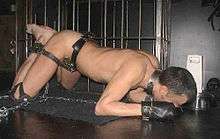Animal roleplay

Animal roleplay is a form of roleplay where at least one participant plays the part of a non-human animal. As with most forms of roleplay, its uses include play and psychodrama.
Animal roleplay may also be found in BDSM contexts, where an individual may take part in a dominant/submissive relationship by being treated as an animal. The activity is often referred to as petplay. However, not all types of animal roleplay within BDSM are petplay and not all petplay in BDSM involves roleplaying as an animal; some can be referred to as primal play and furry play.
Overview
The origins of animal roleplay and petplay are probably various and diverse, again depending upon the participants involved. However, its origins are certainly influenced by costuming, fiction, myth and legend, roleplay and psychodrama in their various aspects. Some of the earliest published images of animal play (especially pony play) are to be found in the work of John Willie, primarily in Bizarre magazine published from 1946 to 1959.
Cultural and ritual use
Non-sexual animal roleplay was a common and integral part of ritual in many tribal cultures both in recent and likely prehistoric times, where a member (or members) of the tribe would take the role physically and often spiritually of an animal that was either revered or hunted. Examples of the former include many of the American Indian tribes and Arctic native peoples. Examples of the latter are evidenced by cave paintings. In 1911, Julia Tuell photographed the last Animal Dance ("Massaum") performed by the Northern Cheyenne of Montana.
It is also sometimes used in education, especially physical education, as a way to encourage people to exercise the body in unusual ways, by mimicking various animals.
Other forms
In manga and anime, a relatively common character type is the "catgirl". A standard catgirl resembles a slim teenage girl with cat ears, a tail, tiny fangs and a propensity for catlike affection or curiosity. Examples include Cat Girl Nuku Nuku, Pink from Dragon Pink and Ms. Furbottom's human form in Sgt. Frog, among others. Real-life costume play, or cosplay, of anime catgirls could be considered a form of pet play. That catgirls are humanoids with lesser attributes of felines means that the costume is an especially simple one, and therefore quite popular among convention-goers. Though kittenlike timidity and submissiveness are prominent elements of catgirl charm, the role does not include the "heavier", more overt kink that is usually synonymous with BDSM pet play.
Some superheroes, heroines, and villains also feature elements related to pet play; such as DC Comics's Wildcat, Catwoman, the Penguin and Vixen, Marvel's Tigra, Man-Wolf and Black Cat, or even Nastassja Kinski's Irena Gallier in the 1982 film Cat People (a remake of the 1942 Simone Simon film), and Miss Kitty from the Brendan Fraser movie Monkeybone. All involve animal qualities taken on by a human. Some would even count the enactment or spiritual belief in therianthropy (werewolves, werecats, etc.) as falling under human animal roleplay or transformation play as well.
Peter Shaffer's 1973 play Equus tells the story of a young man who has a pathological religious fascination with horses, but this appears closer to zoophilia than pet play. Andrew Lloyd Webber's 1981 musical Cats traces a tribe of urban cats, and in 2007 War Horse used full size puppets to play horses on stage.
Erotic scenarios
Like much of erotic play and roleplay, animal roleplay in an erotic or relational context is entirely defined by the people involved and by their mood and interests at the time of play. It ranges from the simple imitation of a vocal "whinnying" of a horse to the barking, panting or playful nudging of a puppy, or playful behaviour of a kitten, to crawling around on all fours and being fed, or petted, by hand. To the greater extremes of dressing up as a pony in modified horse tack, masks, prosthetics and temporary bondage based body modification (such as binding the forearms to the upperarms and/or the calves to the thighs).
Public participation in human animal roleplay is varied. A couple could inconspicuously role-play a silly but loving pet play scene in public, but it would look like one partner is merely stroking the other's neck innocently to the casual observer. In the case of some BDSM fetishists, one partner may wear a dog collar with a leash attached.
The reasons for playing such a character or animal can vary as much as the actual physical manifestations and intensity of the play. Some people enjoy being able to "cut loose" into a different, or more dynamic personality (e.g., were-creatures or catgirls; see other variations). In some cases, pet play is seen as a loving, quiet cuddling time where there is no need for verbalizations and the simple act of stroking, rubbing and holding the other partner is satisfying or reassuring in and of itself for those involved. For others, there may be a spiritual side to it. Some feel closer to their animal totem, while others may identify with something akin to a deeper side or part of their own psyche (known as therianthropy). For still others, there is the experience of power exchange setup in a context or structure which they can accept. Clearly, again, it depends on the people involved and what they bring to it or take from it.
Additionally, some cases could be considered a type of animal transformation fantasy. They can have strong elements of exhibitionism, be totally enjoyed in the privacy of the home, or lie somewhere between either boundary. While not widespread, erotic human-animal roleplay is still enjoyed by a sizable number of people. However, it is still primarily identified with BDSM practice. Though commonly misinterpreted as being associated with furry or other alternative lifestyle activities, that is generally not the case though some instances may exist.
For most participants, it has no connection whatsoever with bestiality, which is controversial and would usually be considered edgeplay in BDSM circles.
Autozoophilia is sexual arousal that depends on acting out or imagining one's self as an animal. Paraphilic interests that involve being in another form have been referred to as erotic target location errors (ETLEs), and autozoophilia would represent an autoerotic form of zoophilia.[1]
Other considerations
Each type of play can focus on a certain "strength" of an animal character. Pony play often involves the practice and training that a horse owner or trainer would put their horse through to learn how to walk, canter, etc., as modified for human limbs. Puppy and kitten play often can involve BDSM related discipline. Cow Play often involves fantasies of lactation and impregnation. The usual limits of safe, sane and consensual apply to roleplay as much as any other activity between humans who accept and respect their partner's interests and limits. For most, this does not include bestiality.
Note: Just because one partner is playing the "pet" does not necessarily make them the passive or submissive play partner in the scene. For example, if the form of pet play is for the meek and timid wife to "transform" into a werewolf or mischievous anime catgirl, she may take the upper hand and dominate the partner. Again, how the play is interpreted is entirely up to the people involved.
BDSM scenarios
Some people believe that they have certain animal 'instincts' and through animal roleplay can let them out. This is especially true in the BDSM communities, where some people 'live' as their chosen animal 24/7. This type of mentality goes beyond roleplay and becomes a full lifestyle for the parties involved. There are also 'hybrids'. These are humans who live part-time as one type of animal, and part-time as another. This is usually determined by the situation.
There seems to be a growing trend among the BDSM scene in animal roleplay, especially pup and kitten play. Playing the role of a pup or kitten is one of giving over complete control over to another, while the 'master or handler' expects only unconditional love and obedience from his/her animal.
Pony play


Pony play is where at least one of the participants dresses to resemble and assumes the mannerisms and character of an equine animal. People involved in pony-play ("ponies") generally divide themselves to three groups[2] although some will participate in more than one category:
- Cart ponies pull a sulky with their owner.
- Riding ponies are ridden, either on all fours or on two legs, with the "rider" on the shoulders of the "pony" (also known as Shoulder riding). Note that a human back is generally not strong enough to take the weight of another adult without risk of injury, so four-legged "riding" is generally symbolic, with the "rider" taking most of their weight on their own legs.
- Show ponies show off their dressage skills and often wear elaborate harnesses, plumes and so on.
A documentary film Pony Passion was produced by British pony play club De Ferre in 2003 showing their club's activities and the 2005 documentary film, Born in a Barn, depicted the lives of several pony-play enthusiasts.[3]
Pony play is sometimes referred to as "The Aristotelian Perversion," in reference to an apocryphal story where the philosopher Aristotle was persuaded to let a woman named Phyllis ride him like a horse, in promised exchange for sexual favors: an episode depicted in various woodcuts and other works of art.[2]
Puppy play

In puppy play, or dog play, at least one of the participants acts out canine mannerisms and behaviors, which is sometimes associated with leather culture. If there is a dominant role it can be taken by a "handler", "trainer", "master", or in the case of someone who also identifies as canine, an "alpha". If there is a submissive this may be considered by a "pup" or a "dog". Unlike other forms of animal roleplay, it is not uncommon for two or more pups to play together as equals, fight for dominance, or play where one is clearly the "alpha".[4] Puppy play is often about being playful, mischievous, and instinctive.[5] Many human puppies like to simplify their desires and motivations as they embrace the side of themselves that acts solely on instinct.[6] In relation to other BDSM play, a "puppy" who is "unowned" or "uncollared" can be referred to as a "stray". Other elements rooted in BDSM play involve bondage and restriction with collars, leashes, cages, and hoods, the pups hands are often covered in mitts, both sexual and non-sexual services are requested, and "training" may take place in order to teach commands.
Kitten play

In kitten play, a person dresses to resemble and assumes the mannerisms and character of a kitten or cat, a characteristic of which is that it keeps some independence and, as part of the fantasy, might retaliate against the partner trying to tame/train him or her. Some might be trained to do tricks such as bring toys back, to beg, or go on walks. Like in puppy play, a "kitten" or "cat" that is unowned or uncollared may be called a "stray."
See also
| Wikimedia Commons has media related to Ponyplay. |
References
- ↑ Lawrence, A. A. (2009). Erotic target location errors: An underappreciated paraphilic dimension. Journal of Sex Research, 46, 194-215.
- 1 2 Malfouka. "Pony people, ponyboys and ponygirls". Retrieved February 14, 2011.
- ↑ http://www.imdb.com/title/tt0476963/
- ↑ What Is An Alpha Pup in Human Pup Play? accessed 18 March 2016
- ↑ Dog play in the BDSM Dictionary Archived May 11, 2008, at the Wayback Machine. accessed 4 July 2008
- ↑ What Is Human Pup Play? accessed 18 October 2013